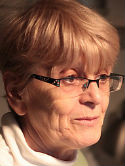Role of Nbs1 in the activation of the Atm kinase revealed in humanized mouse models Journal Article
| Authors: | Difilippantonio, S.; Celeste, A.; Fernandez-Capetillo, O.; Chen, H. T.; San Martin, B. R.; Van Laethem, F.; Yang, Y. P.; Petukhova, G. V.; Eckhaus, M.; Feigenbaum, L.; Manova, K.; Kruhlak, M.; Camerini-Otero, R. D.; Sharan, S.; Nussenzweig, M.; Nussenzweig, A. |
| Article Title: | Role of Nbs1 in the activation of the Atm kinase revealed in humanized mouse models |
| Abstract: | Nijmegen breakage syndrome (NBS) is a chromosomal fragility disorder that shares clinical and cellular features with ataxia telangiectasia. Here we demonstrate that Nbs1-null B cells are defective in the activation of ataxia-telangiectasia-mutated (Atm) in response to ionizing radiation, whereas ataxia-telangiectasia- and Rad3-related (Atr)-dependent signalling and Atm activation in response to ultraviolet light, inhibitors of DNA replication, or hypotonic stress are intact. Expression of the main human NBS allele rescues the lethality of Nbs1-/- mice, but leads to immunodeficiency, cancer predisposition, a defect in meiotic progression in females and cell-cycle checkpoint defects that are associated with a partial reduction in Atm activity. The Mre11 interaction domain of Nbs1 is essential for viability, whereas the Forkhead-associated (FHA) domain is required for T-cell and oocyte development and efficient DNA damage signalling. Reconstitution of Nbs1 knockout mice with various mutant isoforms demonstrates the biological impact of impaired Nbs1 function at the cellular and organismal level. |
| Keywords: | signal transduction; controlled study; unclassified drug; mutation; dna-binding proteins; clinical feature; nonhuman; mutant protein; dna replication; protein domain; protein function; ultraviolet radiation; t lymphocyte; t-lymphocytes; animal cell; mouse; meiosis; animals; cell cycle proteins; mice; mice, knockout; mre11 protein; allele; animal tissue; cell viability; dna damage; atp-binding cassette transporters; cell cycle; cell cycle s phase; cancer susceptibility; genetic predisposition to disease; gene expression; cell maturation; protein protein interaction; animal experiment; animal model; gene product; enzyme activation; phosphorylation; gonad dysfunction; b lymphocyte; carcinogenesis; animalia; b-lymphocytes; mice, transgenic; nibrin; nuclear proteins; b cell lymphoma; dna; gene rearrangement; lymphoma, non-hodgkin; syndrome; protein-serine-threonine kinases; enzyme inactivation; tumor suppressor proteins; atm protein; ionizing radiation; dna repair enzymes; tumor suppressor protein p53; nijmegen breakage syndrome; chromosome breakage; stress; cell cycle g2 phase; binding sites; immunoglobulin class switching; chromosome aberrations; immune deficiency; disease models, animal; atr protein; isoprotein; metaphase; knockout mouse; lethality; gonads; oocyte development; ataxia telangiectasia; chromosome disorders; chromosome fragility |
| Journal Title: | Nature Cell Biology |
| Volume: | 7 |
| Issue: | 7 |
| ISSN: | 1465-7392 |
| Publisher: | Nature Publishing Group |
| Date Published: | 2005-07-01 |
| Start Page: | 675 |
| End Page: | 685 |
| Language: | English |
| DOI: | 10.1038/ncb1270 |
| PUBMED: | 15965469 |
| PROVIDER: | scopus |
| DOI/URL: | |
| Notes: | --- - "Cited By (since 1996): 124" - "Export Date: 24 October 2012" - "CODEN: NCBIF" - "Source: Scopus" |



